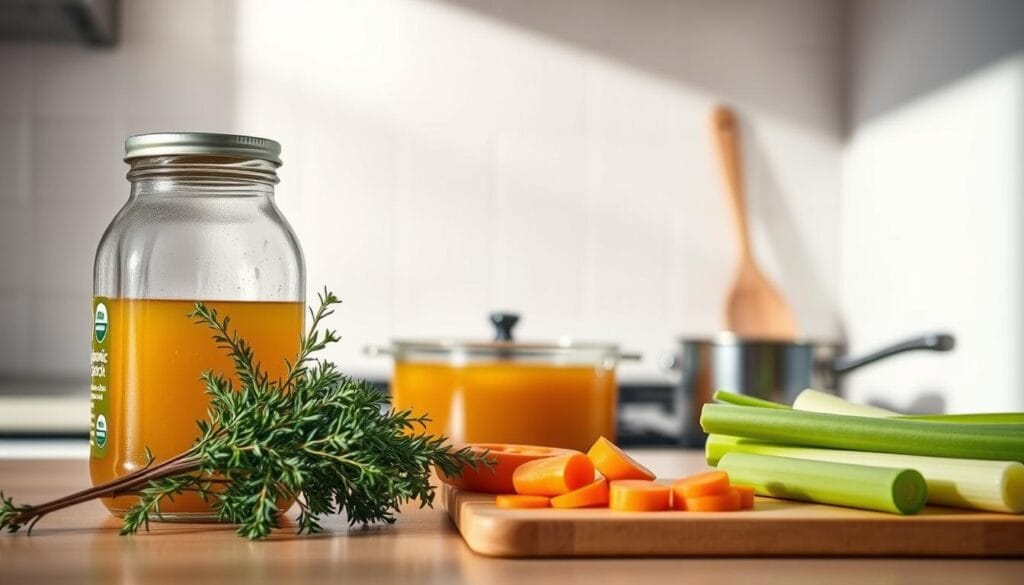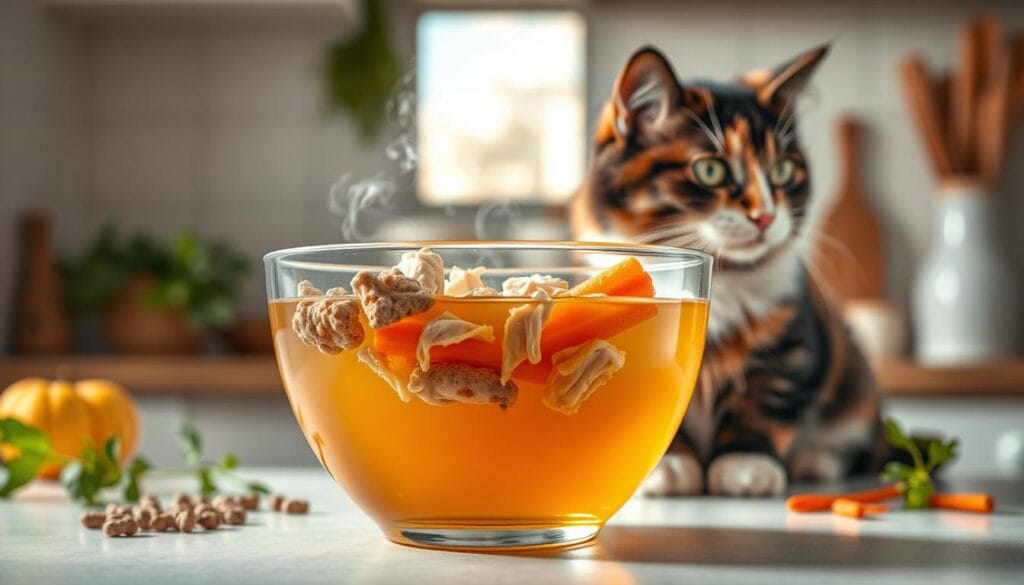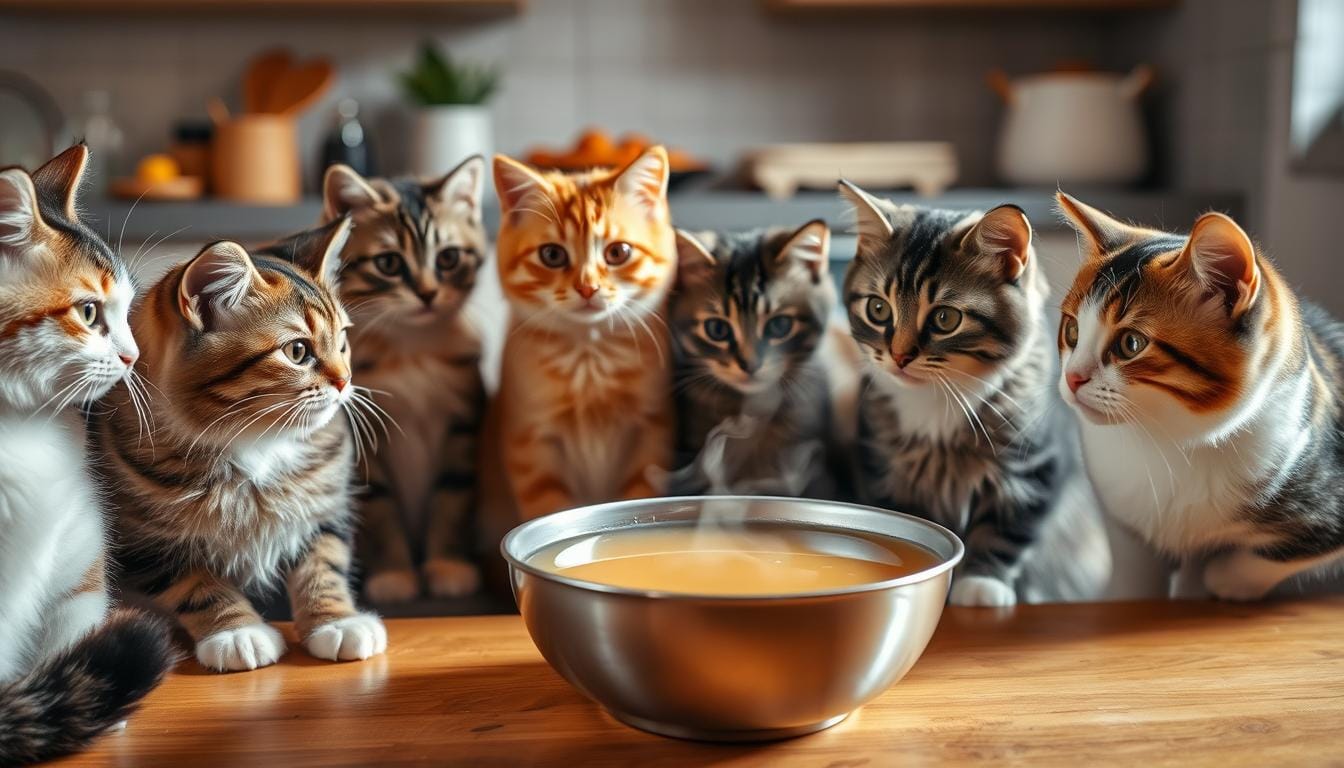Can Cats Have Chicken Broth Safely? Risks & Recommendations
Can Cats Have Chicken Broth? Your feline companion’s curious nose twitches as you stir a warm bowl of homemade soup. That pleading gaze makes you wonder: Could sharing this comfort food help them feel better? For pet parents seeking gentle ways to support picky eaters or recovering animals, broth often feels like a natural solution.
When prepared thoughtfully, this liquid can offer hydration and nutrients without upsetting sensitive stomachs. But store-bought versions frequently hide dangers like excessive sodium or toxic ingredients. The difference between helpful and harmful lies in what’s left out as much as what’s included.
Homemade recipes using plain meat and filtered water provide essential minerals while avoiding garlic, onions, and artificial flavors. Proper cooling ensures the texture remains appealing, and small portions prevent digestive issues. Many veterinarians recommend it as a supplemental treat for hydration support during recovery periods.
This guide will walk you through safe preparation methods, storage tips, and portion control strategies. You’ll learn to identify quality ingredients and understand why some commercial options should stay off your pet’s menu. Let’s explore how to turn a simple kitchen staple into a nourishing boost for your furry family member.
Table of Contents
Understanding Chicken Broth for Cats
Pet owners often mistake human-grade broth for a safe feline treat. While both liquids share similar origins, their formulas differ dramatically. Choosing the right version could mean the difference between nourishing your companion or risking their well-being.

What Sets Cat Broth Apart from Human Broth?
Commercial broths designed for people pack dangerous hidden ingredients. Garlic, onions, and excessive salt appear harmless to humans but can damage feline red blood cells or strain kidneys. Even low-sodium labels often contain unsafe sodium levels for smaller animals.
Specialized formulas skip artificial flavors and preservatives. They prioritize easily digestible proteins from real meat instead of meat by-products. This careful ingredient selection prevents digestive upset while delivering essential nutrients.
Nutritional Insights and Hydration Benefits
Properly prepared broth offers amino acids that support tissue repair and immune function. Collagen from simmered bones promotes joint flexibility and a glossy coat. These elements work together to maintain overall health without overwhelming delicate systems.
Many pets eating dry kibble benefit from added moisture. A few tablespoons mixed into meals can increase water intake by 30-40%. This hydration boost helps prevent urinary tract issues and supports kidney efficiency over time.
Can Cats Have Chicken Broth: Key Nutritional Benefits & Safety Tips
When prepared correctly, a simple broth becomes a powerhouse of essential nutrients. Minerals like calcium strengthen bones, while potassium regulates fluid balance. These elements work together to maintain vital bodily functions without overwhelming your pet’s system.

Glucosamine and chondroitin naturally occur in bone-based broths, supporting joint flexibility. This proves especially valuable for older felines or those recovering from injuries. Glycine, an amino acid, aids liver detoxification and soothes sensitive digestive tracts.
Collagen extracted during simmering promotes healthier skin and reduces shedding. It also improves coat texture, giving fur a noticeable shine. Combined with easily absorbed proteins, these components create a nutrient-dense supplement.
Always skip additives like garlic powder or artificial flavor enhancers. Start with quarter-teaspoon portions to monitor tolerance. Gradually increase to 1-2 tablespoons daily if no adverse reactions occur.
Store-bought options often contain unsafe sodium levels. Homemade versions let you control ingredient quality and concentration. Consult your veterinarian before introducing new foods to address specific dietary needs.
Evaluating Safe Ingredients for Your Cat’s Broth
Creating a nourishing liquid for your pet requires meticulous ingredient scrutiny. One wrong addition could turn a health boost into a hazard. Let’s break down what belongs in the pot—and what should stay far away.
Avoiding Toxic Additives and Unwanted Chemicals
Allium vegetables like onions and leeks top the danger list. These common flavor enhancers destroy red blood cells, leading to life-threatening anemia. Even small amounts of garlic powder in store-bought versions can cause vomiting or lethargy.
Steer clear of grapes, raisins, and chocolate—ingredients sometimes hidden in premade broths. Solanine in green tomatoes or raw potatoes disrupts nervous system function. Always check labels for xylitol, a sweetener that triggers insulin spikes in felines.
Selecting Quality Meats and Gentle Vegetables
Choose boneless, skinless chicken breasts or thighs for lean protein. Organ meats like liver add vital nutrients but use sparingly—too much vitamin A causes toxicity. Rinse all meat thoroughly to remove surface bacteria before simmering.
Finely chop cat-safe veggies like carrots or zucchini. These provide fiber without upsetting digestion. Avoid broccoli or spinach, which may cause gas. Always cook vegetables until soft to prevent choking hazards.
Homemade preparation lets you skip preservatives and control sodium levels. For store-bought options, verify there’s no onion powder or artificial flavors. When in doubt, consult your vet about brand recommendations.
Recognizing the Risks of Unsafe Broth Preparation
A simple mistake in your kitchen could turn a well-meaning treat into a dangerous situation for your furry friend. Even small errors in ingredient selection or temperature control may lead to severe health complications.
Choking Hazards and Digestive Upsets
Cooked poultry bones splinter easily, creating sharp fragments that damage mouths and throats. These shards can pierce intestinal walls, requiring emergency surgery. Always remove bones completely before simmering meat.
Store-bought versions often contain sodium levels 3-4 times higher than safe limits. Over time, this strains kidneys and may cause neurological issues. Homemade recipes let you eliminate salt entirely.
| Risk | Potential Harm | Prevention Tips |
|---|---|---|
| Bone fragments | Internal bleeding | Strain broth twice |
| High sodium | Kidney problems | Use unsalted stock |
| Hot temperature | Mouth burns | Cool to 70°F first |
Spices like onion powder trigger vomiting and diarrhea within hours. Always test new recipes with teaspoon-sized portions. Watch for lethargy or appetite changes afterward.
Lukewarm liquids prevent burns while maintaining appeal. Let mixtures sit 15 minutes before serving. Refrigerate leftovers within two hours to avoid bacterial growth.
How to Prepare Homemade Chicken Broth for Cats
Crafting nourishing broth for your pet begins with proper preparation techniques. Follow these methods to create a flavorful liquid that supports hydration and delivers essential nutrients safely.
Step-by-Step Recipe for a Pet-Friendly Broth
Start with boneless chicken pieces cut into half-inch cubes. This size prevents choking while allowing easy digestion. Use 500g of breast or thigh meat combined with 4-8 cups filtered water in a stainless steel pot.
Add optional organ meats like chopped liver for extra vitamins. Simmer uncovered on low heat for 30-45 minutes. Skim off foam every 10 minutes to keep the broth clear.
- Strain liquid twice through cheesecloth
- Cool to room temperature before serving
- Store leftovers in airtight containers
Guidelines for Using Boneless Chicken and Safe Vegetables
Select skinless poultry to reduce fat content. Rinse meat thoroughly under cold water to remove surface bacteria. Finely dice cat-safe produce like peeled carrots—steam them separately before adding to the pot.
| Ingredient | Preparation | Serving Tip |
|---|---|---|
| Chicken | Cube into ½” pieces | Remove all connective tissue |
| Carrots | Steam until soft | Mash before mixing |
| Water | Filtered or boiled | Adjust quantity for thickness |
Refrigerate batches for up to four weeks. Freeze ice cube portions for single-serving convenience. Always test new recipes with one teaspoon before regular use.
Tips for Cooking and Storing Cat Broth
Mastering broth preparation requires precision in both cooking techniques and storage solutions. Proper methods ensure your pet receives maximum nutrients without exposure to harmful bacteria or texture issues.
Proper Cooking Methods and Time Requirements
Simmer chicken-based liquids for 30-60 minutes to extract flavors while preserving delicate nutrients. Bone varieties need 6-8 hours of low-heat cooking to release collagen safely. Pressure cookers cut bone broth time by half but require careful temperature monitoring.
| Method | Time | Best For |
|---|---|---|
| Stovetop | 30-60 min | Quick chicken broth |
| Slow cooker | 6-8 hrs | Gelatin-rich bone broth |
| Instant Pot | 3-4 hrs | Time-sensitive prep |
Safe Storage Practices and Serving Temperature
Cool liquids to 70°F before refrigerating in glass jars. Homemade batches stay fresh 1-4 weeks when stored below 40°F. Freeze ice cube portions for 3-month storage – thaw overnight before use.
| Storage Type | Duration | Quality Tip |
|---|---|---|
| Refrigerator | 4 weeks max | Label with preparation date |
| Freezer | 90 days | Use silicone molds for portions |
Discard broth if you notice cloudy appearance or sour smells. Jelly-like consistency from collagen is normal when chilled. Always test temperature on your wrist before offering to your kitty.
Understanding the Role of Chicken Broth in a Cat’s Diet
Balancing your pet’s nutritional needs requires understanding where supplements fit into their daily meals. Chicken broth acts as a hydration helper, not a full meal replacement. Most felines need 180-400 calories daily, with broth contributing no more than 10% of that total.
For animals eating dry kibble, adding 1-2 tablespoons boosts moisture intake by 25-30%. This helps prevent urinary crystals and supports kidney function. Always measure portions to avoid displacing essential nutrients from complete cat food formulas.
Consider these scenarios where broth proves useful:
- Senior pets needing softer-textured meals
- Recovering animals requiring appetite stimulation
- Active cats in hot climates needing extra hydration
Monitor weight carefully when introducing liquid calories. A typical indoor cat weighing 10 pounds needs about 200 calories daily – broth should provide 20 calories max. Use low-sodium recipes to maintain proper mineral balance.
| Diet Component | Daily Percentage | Broth Contribution |
|---|---|---|
| Complete Food | 90-95% | Primary nutrients |
| Broth | 5-10% | Hydration boost |
Pair this supplement with regular veterinary checkups to address specific health needs. Properly integrated, it enhances mealtime appeal while supporting overall wellness.
Integrating Broth Safely Into Your Cat’s Regular Meals
Introducing new elements to your pet’s feeding routine requires careful planning. Start with teaspoon-sized portions mixed into their usual food or offered in a separate bowl. This gradual approach helps identify digestive sensitivities while maintaining nutritional balance.
Use cooled broth as a hydration booster between meals or pour it over dry kibble. The liquid softens crunchy textures, making meals easier to chew for older felines. Always ensure fresh water remains available as the primary drink source.
Younger pets under six months should receive no more than two teaspoons daily. Adults can handle up to two tablespoons divided across meals. Monitor your companion closely during initial introductions, watching for changes in appetite or litter box habits.
Store unused portions in freezer-safe containers for convenient single servings. Rotate thawed batches weekly to preserve freshness and nutrient quality. Consult your veterinarian to tailor quantities based on weight, age, and health conditions.
When integrated thoughtfully, this supplement enhances mealtime appeal without disrupting dietary needs. Proper portion control ensures your furry friend reaps the benefits safely.
Read also :
- Dry Cat Food Recipes
- Wet cat Food Recipes
- Special Cat Food Recipes
- Chicken Cat Food Recipes
- Homemade Cat Food Recipes
- Can cats eat chicken and what are the health benefits?
- Can cats have chicken as a protein source? Comprehensive guide
- Can Cats Eat Raw Chicken? Safety Guide for Cat Owners
- Dry Cat Food Brands Loved by Cats and Trusted by Vets
- Best Cat Food for Sensitive Stomach:Top 5 Vet-Approved Picks
- Special Kitty Kitten Food – Learn the Pros and Cons
- prescription cat food-Top 10 Prescription Cat Foods
- Wet Cat Food for Kittens: Top Nutritious Choices 2025
- How Long Can Wet Cat Food Sit Out? Critical Facts
- American Veterinary Medical Association (AVMA)

